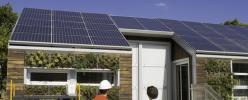What is the Average Monthly Electric Bill with Solar Panels Installed?

Recent research from the Rocky Mountain Institute shows that monthly electric bills for a typical home in Westchester County, New York may rise to $350 a month by 2030.
Yet, the same household may spend $260 or less a month if they’ve installed solar panels and battery storage. The time for solar is now.
Going solar can reduce your electric bill dramatically, to the point where it’s not a significant player in your monthly budget. Some fortunate homeowners can even eliminate their electric bill.
How Much Will Your Electric Bill be After Installing A Home Solar System?
How much will your electric bill be with solar panels installed? Read on to learn how much to expect with your setup after installation.
With optimized household energy consumption and a maximized home solar installation, you can develop a financial equation that balances your electric bill and energy needs. Then, add up the thousands of dollars you’re not spending over the years by using home solar.
Plus, there are bonus points. Because of the costs you avoid in going solar, your benefits will be even greater in states with high electric rates.
And, as energy prices spiral upward, your financial security will become even more advantageous over the 25-year lifecycle of your home solar system. Take control with solar. It’s your home, your energy.

See if you qualify for the
26% federal tax credit
Thanks so much! We'll call you shortly.
Sorry, we are not taking new customers in your area yet
Refer a friend. Get $1000
Stay up to date with Sunrun
How Much is the Average Electric Bill?
Your home is far from average. But for the sake of conversation, let’s talk about averages.
According to recent figures from the Energy Information Administration (EIA), the typical U.S. household uses approximately 10,766 kilowatt-hours (kWh) of electricity per year.
Their monthly average is 897 kWh. And, the household pays 12.57¢ per kWh. Thus, the average American’s electric bill rounds up to $113 per month (897 kWh x 21.57¢ = $112.75).
Here’s a price comparison of electric costs in two states that help create that national average. In 2018, Colorado’s average monthly electric bill was $105, with an average yearly cost of $1,260. On the high side for that same time frame, Connecticut’s figures were $186 and $2,232, respectively. See below for a detailed look at various average electricity bills within the states Sunrun operates in.
| State | Average Monthly Electric Bill | Average Yearly Electric Cost |
|---|---|---|
| Arizona | $110 | $1,320 |
| California | $170 | $2,040 |
| Colorado | $105 | $1,260 |
| Connecticut | $186 | $2,232 |
| Delaware | $110 | $1,320 |
| Florida | $107 | $1,248 |
| Hawaii | $283 | $3,396 |
| Illinois | $112 | $1,344 |
| Maryland | $117 | $1,404 |
| Massachusetts | $194 | $2,328 |
| Nevada | $112 | $1,344 |
| New Hampshire | $176 | $2,112 |
| New Jersey | $140 | $1,680 |
| New Mexico | $110 | $1,320 |
| New York | $160 | $1,920 |
| Oregon | $96 | $1,110 |
| Pennsylvania | $124 | $1,488 |
| Rhode Island | $192 | $2,304 |
| South Carolina | $110 | $1,320 |
| Texas | $100 | $1,200 |
| Utah | $93 | $1,116 |
| Vermont | $158 | $1,896 |
| Washington, DC | $113 | $1,356 |
| Wisconsin | $128 | $1,536 |
How Much Will My Electric Bill be with Solar Panels?
Your electric bill with solar panels is dependent on a few factors. Together, they influence your monthly energy costs. Planning for a brighter tomorrow starts at home today.
Your Home Solar System’s Energy Production
Maximizing your solar installation’s energy generation is key to having reliable, robust electricity for your household. While bigger is not always better, the size of your home solar system directly affects your electric bill.
Unless you can dependably benefit from net metering, often your best bet is installing solar panels that cover 100% of your electricity needs. Be sure to calculate in more kilowatt hours to your system if you intend to increase your electric usage, like charging a hybrid electric vehicle or heating a hot tub.
To achieve maximum energy output from some rooftops, it may be advantageous to install premier, smaller solar panels with a higher electricity yield. Yet, with more available roof space, you can likely meet your electricity needs with larger, lower cost, standard efficiency panels.
Home solar systems typically range in size between 5 to 10 kilowatts. The solar installation size and other factors like shading influence the amount of electricity produced. On average, a 5 kW solar panel installation will produce about 8,000 kilowatt hours a year. This clean, sustainable energy is sufficient to cover the annual energy requirements of many households.
When considering what your electric bill will be with a solar installation, check out your cost benefit of a home battery. Adding battery storage to your solar installation significantly strengthens your financial security from rising electric rates.
With Sunrun solar panels and a Brightbox battery in your home, you’ll have control over your energy usage, electricity during outages, a cleaner environment, and more money in your pocket.
Your Household’s Energy Consumption
How much electricity does your household consume on a regular basis? What are your power necessary equipment and personal habits? Do you conserve energy by hang drying your clothes? Or, do you prefer warm, fluffy towels straight from the dryer?
Obviously, your energy consumption is critical in calculating your electricity bill. According to the U.S. Energy Information Administration, the U.S. average monthly household electricity consumption is 897 kilowatt hours.
So, before investing in a home solar system, clarify your household’s energy consumption. Ensure your home solar installation can generate your electricity requirements. Some households only wish to cover a percentage of their energy consumption. However, many in the solar market want to cover it all and envision negative meter readings.
Home solar systems are variable. Yet, a home solar installation that covers 100% of your energy consumption needs is the straightest route to lower electric bills.
Your Local Electric Rates
Finally, you must factor in what your electric company charges and its rate structure. Today’s U.S. average cost of electricity is predicted to rise in the short-term by 3% each year. Then, you guessed it, energy prices are likely to continue rising incrementally.
Speaking of average, the average energy consumption in a U.S. household multiplied by the average electric rate per kilowatt hour equals an average American monthly electric bill of $113.20.
How Do I Read this Bill?
Clean energy and a reliably comfortable home starts by controlling your energy costs with solar. Most electric bills cover a few standard components. With a home solar system, these components are generally up front and center:
Service Fees
A home solar system won’t remove standard service fees. Service fees are the electric company’s charges for connecting your home to the grid. Generally, it’s a flat monthly cost not based on how much electricity you use.
Taxes
Benjamin Franklin said nothing is certain in this world but death and taxes. Yet, a solar installation sure makes living in your home a lot more fun and financially secure.
Taxes from electric companies are typically based on the amount of grid power used. So, the more electricity generated by your home solar system, the less you pay the tax man.
Here, the financial benefits of using a storage battery are readily evident to reduce your draw from the electric grid.
Electricity Use
After the bottom line on your energy bill, electricity use is the component we look at. The electric company charges based on a volume rate (or the number of kilowatt-hours used).
However, with a home solar system, your electric bill only includes the number of kilowatt hours you’ve used from the grid. They don’t add in any electricity used from your solar panels.
In fact, they don’t even see how much solar energy you’ve used. So, if you only used power generated by your solar panels, the amount of electricity use on your bill would be zero.
Moreover, with a grid connected home solar system, what the electric company does see is how much excess electricity your solar installation gives to the grid. This is where net metering credits come in. Accrued credits increase the financial value and rate of return on your investment.
Typically, your kilowatt hour credit appears on your next bill, or in a total sum at the year’s end. If you have net metering, the following calculation can estimate charges for your electricity usage.
Your Amount of Kilowatt Hours Used from The Grid
- – (minus) Your number of kilowatt hour credits for excess electricity sent to the grid
- = Your electric use charges
When you send more electricity to the grid than your home uses, you’ll have a negative number. This negative kilowatt hour balance may be rolled over at the end of the month. Or, the electric company may give you a cash credit, so you can keep more money in your budget.
Put the sun to work for you with Sunrun solar panels and a Brightbox battery. They’ll capture every sunrise, sunset, and plenty of sunshine rays in between; to brighten your home.
Annual True-up Statement
You may have heard of an annual true-up statement. It’s a sustainable, clean energy way of saying “balance sheet.”
The true-up statement is an annual bill from the electric company that you’ll receive at the end of each 12-month billing cycle. It collectively reconciles all your electricity charges, credits or reimbursements for the previous 12 months.
Typically, the statement is a happy round up of your reduced electricity use from the grid. This translates into household financial gains from your solar panels’ productivity.
In some cases, though, there may be a balance due on the final electric bill of your annual billing cycle. Unplanned changes in your lifestyle may impact electricity usage and increase your statement balance.
In addition, keep in mind that any remaining credits listed on your true-up statement are zeroed-out before your next billing cycle begins. So, throw a party and use them while you got’em.
Sunrun gives you the freedom to choose and control how you power your home. We’re putting panels on your roof, a battery in your home and the power in your hands.
How Do Current Costs Stack Up to Past Prices?
In 2008, the average U.S. household paid 9.74¢ per kilowatt hour of electricity. By 2018, the rate had increased to 12.57¢ per kilowatt hour.
While a difference of 2.83¢ may not seem like a lot, it grows up to be an annual increase of 2.9%. So, the average electric bill for Americans is 29% more expensive than 10 years ago. That’s a considerable amount of cash that could have gone elsewhere… like a down payment, student loans, or retirement.
Solar Prices are Predictable, Electric Rates Are Not
The EIA’s Annual Energy Outlook for 2018 predicted an average national increase in electric rates from 12.57¢ per kilowatt hour in 2018 to 14¢ per kilowatt hour in 2028. Here’s an example of how this increase impacts some households.
In 2018, typical Arizona electric rates were a negative 3% below the national average. Yet in 2028, the state’s electric rates are projected to increase 9% above their 2018 cost for similar usage.
Sure, energy prices go up and down. But, over the long-term, they pretty much always go up. And, electric rate increases are typically beyond your control.
So, step off this stair master of endless rate increases—you’re not getting anywhere. Go with a home solar system. Take control of your household budget with predictable electric bills. And, rest assured you’re doing your part for a sustainable community.
Solar panels protect your wallet from rate increases and lock in lower costs. Imagine clean, affordable, reliable energy—today and for years to come. Together, we you can make it happen.
Brighter Days with Sunrun
There’s plenty of sun to go around. Join the solar energy market. To get you on your way, Sunrun offers solar leases and power purchase agreements (PPAs). These options both give you the energy cost control and environmental benefits of a home solar system. We also have cash options if you want to buy and maintain your own solar system.
Sunrun is the easiest, smartest way to join the solar energy revolution. All Sunrun service agreements include 25 years of support*—guaranteed.
To make the right decision for your budget, it’s good to have a solar lease and PPA bills explained.
In general, a solar company does the installation. The solar company then leases the equipment installed on your roof to you at a fixed monthly amount. Or, they can sell electricity that the panels generate to you at a set price per kilowatt hour. Here’s how they affect your bill:
Solar Lease:
If you like consistency, this is the one for you. With a solar lease, the bill from your solar provider is the same every month. This fixed figure is established by the amount of power your panels are designed to yield over their 25-year lifespan. That amount is then divided into consistent monthly payments for the term of your lease.
Solar PPA:
If you’re more inclined to play the odds, consider a PPA. Under a Solar PPA, you pay the solar company a fixed rate per kilowatt hour generated by your home solar installation. This rate is generally less than that charged by the electric company.
If you want to go for a solar lease or PPA, we'll answer all your questions about understanding your new electricity bill. We break it down and make it manageable.
Bigger Benefits with a Battery
Obviously, homeowners in states with higher electric bills will achieve greater financial gains from a home solar battery installation.
With lower electricity bills and power during blackouts, battery storage simply can’t be beat. Brightbox home battery system keeps your house humming for approximately 8 to 12 hours at night or during a blackout. Your peace of mind recharges every day along with your home solar battery.
Brightbox enables you to store excess power produced by your panels. Then, you can use it to power up the house when you need it most. With time-of-use (TOU) rates, solar panels enable you to shift your energy consumption away from expensive on-peak prices to reduce your electric bill.
Plus, a home solar installation further increases your financial gain from net energy metering (NEM). With solar battery storage, you use even more of electricity generated by your panels and send any excess to the grid for credit.
Sunrun’s home solar systems are customized to your house structure, lifestyle, energy use and financial goals. We’ll guide you through the process every step of the way, from contract through installation and maintenance.
Incentives Increase Your Rewards
Today is a good day to go solar. There are many state and local incentives that sweeten the pot for investing in a home solar system. Visit the Database of State Incentives for Renewables & Efficiency (DSIRE) for comprehensive information on solar financial incentives.
Incentives reduce your overall solar installation, and accelerate the rate of return on your investment. The federal solar tax credit gives you a dollar-for-dollar reduction against your federal income tax. Currently, the residential federal solar tax credit gives you a dollar-for-dollar reduction against your federal income tax equal to 26% of the final cost of solar energy systems you install on your home. This benefit exists through December 31, 2022. In 2023 the residential tax credit will step down step down to 22%. In 2024, the tax credit for residential solar ends.
These reduced initial costs available now, plus your lower electric bills from a home solar installation, make going solar today a wise decision.
What It All Means
Installing solar panels and battery storage will have a positive impact on your electric bill. Overall, the amount depends on a few variables. The primary factors are: the size of your solar installation, if you have battery storage, your amount of energy consumption, and your electric rates.
In the big picture, your electric bill with a home solar system is based on your energy consumption needs and your electricity production goals. An appropriately designed solar installation can make it possible to absolutely minimize your monthly payments.
And, this financial incentive will only increase as electricity costs rise. Over the lifespan of your system, you’ll see that investing in solar panels can reward you…with tens of thousands of dollars that would otherwise fly out the window.
After installing solar, feel good supporting a sustainable, clean environment by comparing your previous year’s electric bill with your new “solar panel bill” for the same month. Soon, you’ll just glance to see how much electricity your solar panels are producing and how much your household is using.
Sunrun can help you feel knowledgeable on how solar panels will influence your electric bill. And, we’ll ensure you have enough understanding to know you’re on the right path to energy security.
The Time To Go Solar is Now
Forget financial uncertainties from electric bills. Home energy is yours to control. Join the thousands of Americans harnessing our sun’s abundance and enjoying energy independence.
You can change the way you power your life. Now is the time to follow your aspirations for lower electric bills, increased peace of mind, and a smaller carbon footprint.
At Sunrun, we know there is a better way and we’re creating it today. When you want to talk about solar for your home, our team is ready. See if you qualify today.
David Zeledon
Sources:
1. https://blog.pickmysolar.com/your-electric-bill-after-going-solar
2. https://blog.pickmysolar.com/your-pge-bill-after-solar-how-to-understand
3. https://news.energysage.com/much-solar-panels-save/
4. https://www.sandbarsolar.com/news/why-is-my-electric-bill-so-high-with-s...
5. https://www.bloomberg.com/amp/news/articles/2018-03-14/sunrun-sees-your-...
6. https://www.tesla.com/support/impact-of-solar-on-your-electricity-bill
7. https://www.vivintsolar.com/blog/solar-bills-explained
** https://www.statista.com/statistics/183700/us-average-retail-electricity...
** https://www.eia.gov/electricity/monthly/epm_table_grapher.php?t=epmt_5_06_b
Recommended Articles
-

Solar Battery Storage
A device that reserves energy for later consumption that is charged by a connected solar system.
-

Solar EPC Company
An EPC company provides a full-service experience to seamlessly acquire a solar installation.
-

Save With Solar and Smart Home Energy Management
That whole “getting smart” concept is what Sunrun has been working on within the residential...
-

Solar Racking System
Used to safely fix solar panels to various surfaces such as roofs, building facades, or the ground.